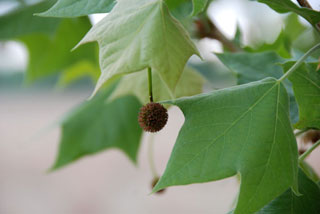SYCAMORE
|
 |
| File Size: 45 KB |
|
|
|
Platanus occidentalis L.
|
| Geary County, Kansas |
| Height: 60-100 feet |
| Family: Platanaceae - Sycamore Family |
| Flowering Period: April, May |
|
| Trunks: | | Straight and unbranched below or often dividing near ground into several secondary trunks; diameter 5 to 10 feet; crown broad, open, irregular; bark of young trees grayish-green and white-mottled; bark of mature trees pale reddish- or yellowish-brown, thin, with plate-like scales that separate and peel off, exposing greenish or whitish inner bark. | | Twigs: | | Branches large, crooked, spreading; bark nearly white with thin greenish-brown sheets peeling off; twigs coarse, rigid, zigzag, enlarged at nodes; lateral buds conical, blunt, reddish-brown; leaf scar a narrow ring encircling the bud; bundle scars 5. | | Leaves: | | Alternate, simple, deciduous, broadly egg-shaped or kidney-shaped, 2.5 to 8+ inches long and wide, thin, firm, palmately 3-5-veined, pubescent on veins below, glabrous when mature; light green above, paler beneath; 3-7-lobed or occasionally un-lobed; lobes broad, spaces between lobes shallow, rounded; basal lobes often smaller; margins coarsely-toothed to entire; stalks stout, 1 to 2.8 inches long; stiplues leaf-like. | | Flowers: | | With the leaves; male and female flowers on same tree; borne in dense spherical heads; staminate heads greenish, .3 to .4 inch in diameter; stalks short, hairy; pistillate heads reddish, .4 to .5 inch in diameter; stalks long, slender; sepals 3-6, minute; petals 3-6, minute; stamens 3-6 (usually 4); styles long, red, incurved. | | Fruit: | | October; achenes in spherical heads about 1 inch in diameter; persist through the winter; stalks slender, 3 to 6 inches long, drooping; achenes narrow, conical with wide end out, about .4 inch long, brown; tuft of brownish hairs around base, nearly equaling achene body. | | Habitat: | | Borders of streams and lakes, rich bottom ground, moist woods; occasionally limestone uplands; rich or rocky alluvial soils. | | Distribution: | | East half of Kansas | | Origin: | | Native | | Uses: | | Native Americans steeped the inner bark and took the tea for colds, coughs, dysentery, the measles, and tuberculosis. An infusion of sycamore and honey locust bark was used as a gargle to treat sore throats and an infusion of sycamore bark and roots was used to soak the feet for rheumatism.. | | Comments: | | Sycamore is one of the largest trees in Kansas and is sometimes planted as an ornamental. Greek platanus "flat" alluding to the leaves. The wood is heavy, tough, coarse-grained, pale reddish-brown, and is difficult to split. |
|
| Sycamore pistillate flowering head |  | | 61 KB | | Geary County, Kansas |
| | Sycamore |  | | 152 KB | | Geary County, Kansas |
| | Sycamore leaf |  | | 74 KB | | Geary County, Kansas |
| | Sycamore bark |  | | 82 KB | | Geary County, Kansas |
| | Sycamore ripening flower head |  | | 61 KB | | Geary County, Kansas |
| | Sycamore fruit |  | | 45 KB | | Geary County, Kansas |
| | Sycamore |  | | 98 KB | | Geary County, Kansas |
| | Sycamore in winter |  | | 160 KB | | Konza Prairie, Riley County, Kansas |
| | Sycamore branch |  | | 115 KB | | Riley County, Kansas |
| | Sycamore branches |  | | 152 KB | | Riley County, Kansas |
| | Sycamore bud |  | | 25 KB | | Konza Prairie, Riley County, Kansas |
| | Sycamore buds |  | | 24 KB | | Konza Prairie, Riley County, Kansas |
| | Sycamore bark |  | | 184 KB | | Dickinson County, Kansas |
| | Sycamore bud |  | | 58 KB | | Konza Prairie, Riley County, Kansas |
| | Sycamore in winter |  | | 219 KB | | Konza Prairie, Riley County, Kansas |
| | Sycamore in winter |  | | 196 KB | | Tallgrass Prairie National Preserve, Chase County, Kansas |
| | | | |
|
|
|